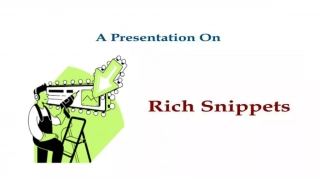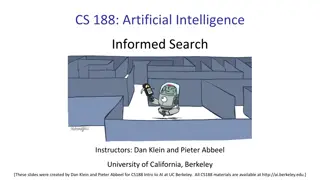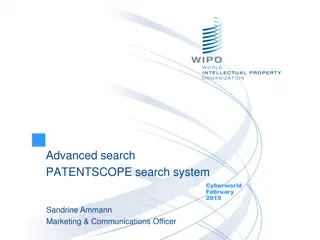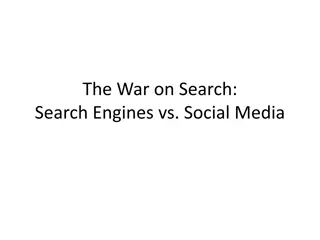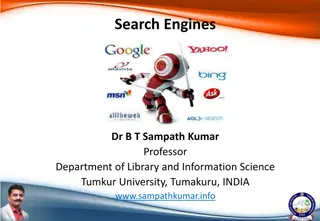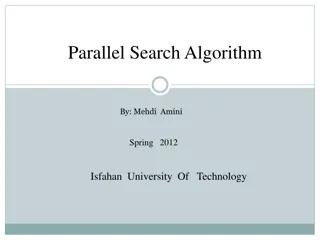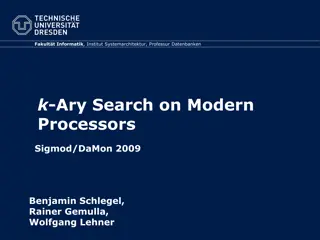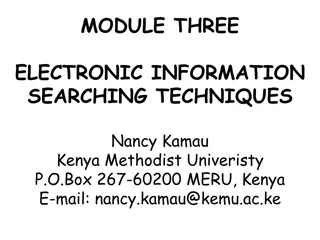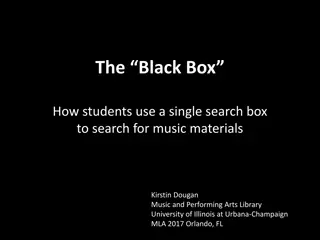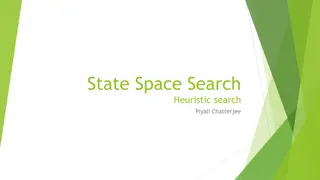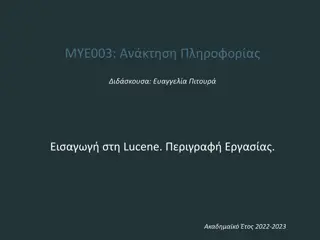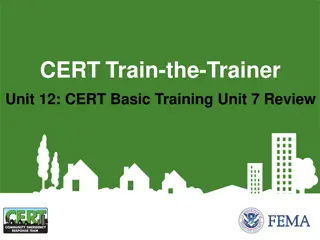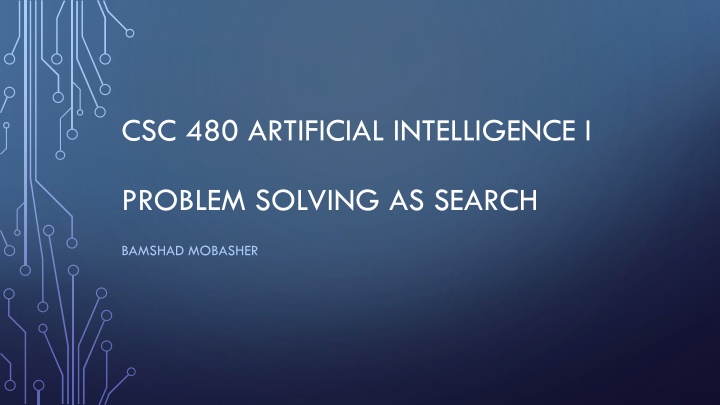
Problem Solving in AI: Search Methods and Knowledge Representation
Explore the power of search algorithms in problem-solving for artificial intelligence. Understand the significance of representing states, actions, and goals in search-based problem-solving approaches. Learn how agents navigate state-space graphs to find optimal solutions efficiently.
Download Presentation

Please find below an Image/Link to download the presentation.
The content on the website is provided AS IS for your information and personal use only. It may not be sold, licensed, or shared on other websites without obtaining consent from the author. If you encounter any issues during the download, it is possible that the publisher has removed the file from their server.
You are allowed to download the files provided on this website for personal or commercial use, subject to the condition that they are used lawfully. All files are the property of their respective owners.
The content on the website is provided AS IS for your information and personal use only. It may not be sold, licensed, or shared on other websites without obtaining consent from the author.
E N D
Presentation Transcript
CSC 480 ARTIFICIAL INTELLIGENCE I PROBLEM SOLVING AS SEARCH BAMSHAD MOBASHER
INTRODUCTION TO SEARCH Search is one of the most powerful approaches to problem solving in AI Search is a universal problem solving mechanism that Systematically explores the alternative paths in the problem space Finds the sequence of steps towards a solution Problem Space Hypothesis (Allen Newell, SOAR: An Architecture for General Intelligence) All goal-oriented symbolic activities occur in a problem space Search in a problem space is claimed to be a completely general model of intelligence
SEARCH AND KNOWLEDGE REPRESENTATION Goal-based and utility-based agents require representation of: states within the environment actions and effects (effect of an action is transition from one state to another state) Utilities / Goals Problems can often be formulated as a search problem The collection of states and transitions among these states based on available actions can be represented as a graph structure To satisfy a goal, agent must find a sequence of actions (a path in the state-space graph) from the starting state to a goal state. To do this efficiently, agents must have the ability to reason with their knowledge about the world and the problem domain which path to follow (which action to choose from in each step) how to determine if a goal state is reached OR how decide if a satisfactory state has been reached.
STATING A PROBLEM AS A SEARCH PROBLEM Need to specify the following: S State space S A successor function: successors(x) given state x in S returns a set of possible next states Cost of a move from one state to another The initial state s0 Goal test: Boolean g = isGoal(x) 1 2 3
STATE-SPACE GRAPH The state-space graph is a representation of all possible legal configurations of the problem resulting from applications of legal operators each node in the graph is a representation a possible legal state each directed edge is a representation of a possible legal move applied to a state (resulting in a new state of the problem) States: representation of states should provide all information necessary to describe relevant features of a problem state Operators (described by the successor function): Operators may be simple functions representing legal actions; Operators may be rules specifying an action given that a condition (set of constraints) on the current state is satisfied In the latter case, the rules are sometimes referred to as production rules and the system is referred to as a production system This is the case with simple reflex agents.
EXAMPLE (ROMANIA) Initial Situation On Holiday in Romania; currently in Arad Flight leaves tomorrow from Bucharest Formulate Goal be in Bucharest Formulate Problem states: various cities operators: drive between cities Find Solution sequence of cities (with roads between them) must start at starting state and end in the goal state
EXAMPLE (ROMANIA) Given a State Space, the problem is defined by four items: operators (or successor function S(x)) e.g., Arad ==> Zerind path cost (additive) e.g., sum of distances, number of operators executed, etc. initial state e.g., ``at Arad'' goal test, can be explicit, e.g., x = ``at Bucharest'' A solution is a sequence of operators leading from the initial state to a goal state Arad ==> Sibiu
EXAMPLE: VACUUM WORLD States: Initial State: both rooms dirty; Agent in room A Goal test: No dirt note that there are two goal states Problem: 8 possible states Successor function: go left, go right, suck dirt Solution: Sequence of actions (applications of the successor function) leading to one of the goal states Two rooms (A and B); Dirt or no-dirt The agent may be in either room Goal states
VACUUM WORLD STATE-SPACE GRAPH State-space graph does not include initial or goal states Search Problem: Given specific initial and goal states, find a path in the graph from an initial to a goal state Such a path represents a solution to the problem which can then be executed by the agent
EXAMPLE: THE 8-PUZZLE States? Operators? move blank left, right, up, down Goal Test? = goal state (given) Path Cost? One per move Represented by the integer location of tiles
8-PUZZLE: SUCCESSOR FUNCTION 8 2 7 3 4 5 1 6 8 2 8 2 7 8 2 7 3 4 7 3 4 6 3 4 5 1 6 5 1 5 1 6
SOLUTION TO THE SEARCH PROBLEM A solution is a path connecting the initial to a goal node (any one) There may be many solutions In some cases, there may be no solution The cost of a path is the sum of the edge costs along this path An optimal solution is a solution path of minimum cost
SEARCHING THE STATE SPACE Often it is not feasible to build a complete representation of the state-space graph A problem solver must construct a solution by exploring a small portion of the graph For a specific search problem (with a given initial and goal state) we can view the relevant portion of the graph as a search tree
SEARCHING THE STATE SPACE Search tree
SEARCHING THE STATE SPACE Search tree
SEARCHING THE STATE SPACE Search tree
SEARCHING THE STATE SPACE Search tree
SEARCHING THE STATE SPACE Search tree
PORTION OF SEARCH TREE FOR AN INSTANCE OF THE 8-PUZZLE PROBLEM 5 6 7 4 1 3 8 2 5 6 7 4 1 3 8 5 6 7 4 8 2 1 3 2 5 1 3 4 8 2 5 6 7 1 4 8 2 5 6 7 4 1 3 8 2 5 6 7 4 8 1 2 6 7 3 3 6 5 1 3 4 8 2 5 1 6 3 4 8 2 5 6 7 1 8 3 4 5 6 7 1 3 4 8 2 5 6 7 8 1 2 5 4 6 3 8 1 2 5 6 7 4 3 8 1 2 5 6 7 4 1 8 2 3 4 3 7 7 2 7 6 1 7 5 4 8 2 6 7 5 1 3 4 8 2 5 7 1 6 3 4 8 2 1 6 3 4 8 2 . . . 5 7 3
EXAMPLE: BLOCKS WORLD PROBLEM World consists of blocks A, B, C, and the Floor Can move a block that is clear on top of another clear block or onto the Floor State representation: using the predicate on(x,y) on(x,y) means the block x is on top of block y on(x, Floor) means block x is on the Floor on(_, x) means block xhas nothing on it (it is clear ) Can specify operators as a set of production rules: 1. on(_, x) on (x, Floor) 2. on(_, x) and on(_, y) on(x, y) Initial state: some initial configuration E.g., on(A, Floor) and on(C, A) and on(B, Floor) and on(_, B) and on(_, A) Goal state: some specified configuration E.g., on(B,C) and on(A,B) A C B
BLOCKS WORLD: STATE-SPACE GRAPH on(_, x) on (x, Floor) 1 on(_, x) and on(_, y) on(x, y) 2 A B 2 2 B C A C A C B 1 1 B A C 1 1 2 2 C B 2 2 2 2 A B C A A C A C B B C B A 1 1 1 1 2 2 2 A C 2 C B B A C B B A C A 1 1 1 1
BLOCKS WORLD: A SEARCH PROBLEM Search tree for the problem A A C B A B C B C B A C A C B Notes: 1. Repeated states have been eliminated in diagram. 2. The highlighted path represents (in this case) the only solution for this instance of the problem. 3. The solution is a sequence of legal actions: move(A, Floor) move(B, C) move(A, B). A C B C B B B C A A C B C A A C A A B C A B C B B C C A B A
8-QUEENS PROBLEM Place 8 queens in a chessboard so that no two queens are in the same row, column, or diagonal. A solution Not a solution
FORMULATION #1 States: all arrangements of 0, 1, 2, ..., or 8 queens on the board Initial state: 0 queen on the board Successor function: each of the successors is obtained by adding one queen in an empty square Arc cost: 1 (irrelevant) Goal test: 8 queens are on the board, with no two of them attacking each other 64x63x...x53 ~ 3x1014 states
FORMULATION #2 States: all arrangements of k = 0, 1, 2, ..., or 8 queens in the k leftmost columns with no two queens attacking each other Initial state: 0 queen on the board Successor function: each successor is obtained by adding one queen in any square that is not attacked by any queen already in the board, in the leftmost empty column Arc cost: 1 (irrelevant) Goal test: 8 queens are on the board 2,057 states
PATH PLANNING What is the state space?
FORMULATION #1 Cost of one horizontal/vertical step = 1 Cost of one diagonal step = 2
OPTIMAL SOLUTION This path is the shortest in the discretized state space, but not in the original continuous space
FORMULATION #2 Visibility graph Cost of one step: length of segment
SOLUTION PATH The shortest path in this state space is also the shortest in the original continuous space

